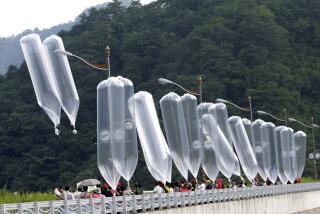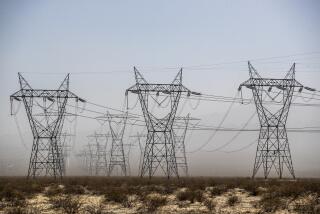Focus: North Korea amps up worries about potential threat to the U.S. power grid
The scenario is apocalyptic: The United States plunges into darkness after its electrical grid goes down— not just for a few hours or even a few days, but a vulnerable power system could take 18 months to recover, so long a period of time that millions would die.
The reason? An electromagnetic pulse (EMP) attack come from a terrorist group or rogue state using a nuclear weapon detonated in the atmosphere.
It sounds like something out of the most dystopian of Hollywood disaster movies.
But news that North Korea recently launched four missiles that traveled 620 miles before landing in the Sea of Japan has heightened concerns among those who have warned that an EMP attack that could essentially vaporize the U.S. energy infrastructure.
“I think this is the principal, the most important and dangerous, threat to the United States,”said James Woolsey, former chief of the Central Intelligence Agency from 1993 to 1995.
“If you look at the electric grid and what it’s susceptible to, we would be moving into a world with no food delivery, no water purification, no banking, no telecommunications, no medicine. All of these things depend on electricity in one way or another,” Woolsey said in an interview with the Union-Tribune.
Others acknowledge the grid needs to be bolstered but are not as fearful of a potential doomsday.
“I’m not on knife’s edge,” said Rob Manning, vice president of transmission for the reseach sector of the Electric Power Research Institute (EPRI). “EMP is a real threat, as is any number of of things that we deal with on a daily basis. So all we can do is try to understand those threats greater and create ways to mitigate them or recover from them effectively.”
What exactly is an EMP?
A short burst of electromagnetic energy, an EMP can occur in nature but with the dawn of the Atomic Age, U.S. and Soviet military officials and scientists soon learned EMPs can also be created when they tested nuclear weapons in the atmosphere.
In 1962, at the height of the Cold War, the U.S. military exploded a nuclear weapon high above an atoll in the Pacific that unexpectedly resulted in an EMP that blew out street lights and knocked out telephones in Hawaii, some 900 miles away.
The abrupt surge of energy is not believed to harm humans physiologically but the pulse could create massive currents that would blow through power lines, destroying electrical transformers and damaging power plants.
While EMPs from outside sources have been popularized in films such as the 1995 James Bond movie “GoldenEye” and “The Matrix,” Mother Nature can deliver her own knockout blow.
In 1859, a powerful, geomagnetic storm known as the Carrington Event produced auroras around the world and caused telegraph systems in North America and Europe to fail.
Today the anxiety comes from an enemy initiating what’s called a “high-altitude EMP” by attaching a nuclear weapon onto a satellite, then detonating it as the satellite passes over the center of the U.S., inflicting the most possible damage.
North Korea already has two satellites that fly over the U.S. on a south-to-north trajectory.
“One of the myths out there is that you need a high-yield weapon to do an EMP attack,” said Peter Vincent Pry, chief of staff of the congressional EMP Commission who also served in the CIA. “Even a low-yield, primitive weapon like the bomb used in Hiroshima will produce a potentially catastrophic EMP field because it’s simply attacking things that are not hardened.”
The EMP Commission was appointed by Congress to assess the threat and in 2004 and 2008 issued reports urging a national commitment to protect everything from the mobile devices millions have become increasingly reliant upon to the power system itself from a potential EMP meltdown.
In its 2008 report, the EMP Commission estimated that within 12 months of a nationwide blackout, up to 90 percent of the population could die from starvation, disease and an overall breakdown of society.
Last month, EPRI released the first of a series of reports from a study looking at the impacts of a single, high-altitude electromagnetic pulse.
The study concentrated on the fleet of 37,000 bulk power transformers in the continental U.S.
Such large transformers, commonly seen in substations, are greater than 69,000 volts and convert electricity from high-voltage electricity to levels that are distributed around neighborhoods.
“We found that there would likely be some failures but those failures are relatively small in nature and not in the hundreds as had been contemplated from some of the reports in the past,” said EPRI’s Manning.
Manning added that “while I think this is good news,” he emphasized that at least four more reports will follow before the entire study is scheduled to wrap up in April 2019.
The EPRI research is funded by 50 utilities across the country, including two from California — Southern California Edison and Pacific Gas & Electric.
The EMP Commission’s Pry blasted the study, alleging that EPRI is compromised by having the study bankrolled by utility companies that he says have dragged their feet on bolstering the grid.
“It’s what I call the junk science EPRI study and you can quote me on that,” Pry said.
EPRI officials insist their study is unbiased.
“We are a fiercely independent organization,” Manning said. “That’s been our history over the last 40 years and that’s very much our mantra. And utilities know that. When they fund us they recognize the results may or may not be the results they would like to see but they will be the right, accurate results.”
Some have said alarm over EMP has been overstated, dismissing it as fear-mongering “for the tinfoil hat crowd” but Pry said in 2009 another congressional commission headed by former secretaries of defense William Perry and James Schlesinger came to the same conclusion as the EMP Commission.
The United Kingdom has also looked into potential risks of a nuclear-detonated EMP. “Our vulnerabilities are huge,” said the chairman of a committee report to Parliament in 2012.
So how much would it cost to harden the system?

The EMP Commission nine years ago estimated it would cost about $2 billion to protect the electric grid.
“I think that would be a bare beginning,” said Woolsey, who has co-authored a number of opinion pieces with Pry. “Most of the estimates I hear from people (to strengthen) the grid and the web as a whole is in the tens of billions.”
Scott Stewart, who supervises analysis of terrorism and security issues for the geopolitical consulting group Stratfor, said, “I honestly believe that our grid is vulnerable.”
But at the same time, Stewart said a cyberattack that could take down the grid is “far, far” more likely than a high-altitude EMP because a cyberattack would be easier for the perpetrators to hide their involvement.
“If you’re launching a weapon, it’s not difficult to track back who that was,” Stewart said. “There are ways you can even track back the nuclear material used to its originator. Basically, you’re going to leave your address, your fingerprints, if you conduct an attack using a weapon.”
Woolsey said he’s most concerned about North Korea because it already has nuclear weapons and “is ruled by a wild man (Kim Jong Un). And I’ll be about equally concerned with Iran as soon as they get a nuclear weapon, which I think will not be too long from now.”
But Stewart said an EMP attack with a nuclear component would be interpreted by the U.S. as an act of war.
“Nuclear weapons give (Kim) a deterrent,” Stewart said. “A deterrent that you can draw a nuke on Seoul (South Korea) very easily is far more of a deterrent than an EMP strike against the United States. Nothing would take his government down quicker than an actual war against the U.S.”
Attacks on the grid can also come from more conventional sources.
Superstorm Sandy walloped the East Coast in 2012 resulted in 147 deaths, more than $50 billion in damages and knocked out power to 8 million people.
And in a violent incident that still has not been resolved, gunmen in 2013 took part in a military-style raid, outsmarting security cameras and sensors and damaging 17 transformers with high-powered weapons at a PG&E substation outside San Jose.
The leaking transformers were shut down by remote operators but more than $15 million worth of damages were reported. The FBI launched an investigation but the shooters have not been found.
“Nobody responsible, I think, says this is not a huge problem,” Woolsey said. “It’s somewhere between huge and catastrophic. We really need to do something to preserve the resilience of the electric grid.”
Business
rob.nikolewski@sduniontribune.com
(619) 293-1251 Twitter: @robnikolewski
More to Read
Sign up for Essential California
The most important California stories and recommendations in your inbox every morning.
You may occasionally receive promotional content from the Los Angeles Times.











